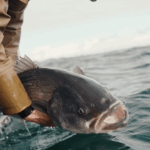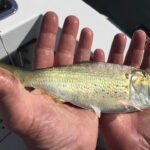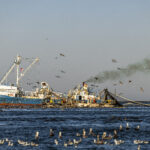
Release Mortality Revisited: New Research from Massachusetts DMF
Feature Photo Credit: Robbie Tartaglia What’s going on? For decades, striped bass management relied on a
On Thursday, the Atlantic States Marine Fisheries Commission’s Atlantic Striped Bass Board met to consider Draft Addendum VI for Public Comment.
If you’re up to speed on all of this, you know the background. If you’re not, we suggest reading our Striped Bass 101 series (link to part one) which lays it all out clearly.
The short version, however, is that the Commission completed a benchmark stock assessment early this year. What it told us, in no uncertain terms is that the striped bass stock is overfished (it’s below the “Female Spawning Stock Biomass” (SSB) threshold – what scientists believe is a healthy level) and overfishing is occurring (we’re removing fish at a rate that is higher than the “fishing mortality threshold” – which means we are fishing at a rate that’s not allowing us to get to the SSB Target). Again, our Striped Bass 101 series will clarify all of this.
Amendment 6 to the Striped Bass Management Plan is very clear that should the striped bass stock become overfished, action must be taken to get fishing mortality back above the threshold and to a level that prevents overfishing- the “fishing mortality target”, and then there must be a rebuilding plan to get the stock back to “female spawning stock biomass target”.
In other words, lower fishing mortality to the point that would theoretically rebuild the stock within 10 years.
The Striped Bass Board voted at its May meeting to initiate an Addendum to get fishing mortality back on track. What was conspicuously missing was any mention of rebuilding the stock. Presumably, curbing fishing mortality to a suitable level, and preventing “overfishing” will rebuild the stock. And theoretically, it will. But it was not clear whether or not it would do so in 10 years or less.
So, to address the fishing mortality issue, in May the Commission’s Technical Committee (TC) determined that an 18% reduction in removals would get us back to a place where we were no longer “overfishing”. But again, it gave no guidance on rebuilding. That is mostly due to the fact that the board didn’t ask for that information.
At that May meeting the board moved to task the TC with developing a Draft Addendum that would contain a suite of management options (i.e., size and bag limits) that had a 50% probability getting us that 18% reduction.
Why only 50%? Well, that’s a long story, deserving of it’s own blog post. But the short version is that’s the minimal federal requirement for management actions and has kind of become the standard for the Commission.
Getting back to the rebuilding part, just getting the analysis of what it would take to rebuild was like pulling teeth. I thought I had asked for that at the May meeting, but the interpretation was how long it would take to rebuild with the aforementioned 18% reduction. They did do that analysis, and it turns out it will take 13 years instead of 10. Getting options in the Draft Addendum for a 10-year rebuilding time frame would have pushed the timeline back to a point where we wouldn’t be able to have new regulations in place for the 2020 fishing year, so that didn’t happen.
Brass tacks? We have a public document now containing a suite of options that intend to cut removals by 18% of the 2017 base year. It does NOT address rebuilding within 10 years. But given the conversation, the Board seemed clear in its intent to do so. So, the plan seems to be “let’s see how this works and if it doesn’t look like we’re on track to rebuild, we can make adjustments”. Not a terrible outcome in our opinion.
Now, what happens next? Well, a public comment period on the Draft Addendum will likely open very soon. Each state from North Carolina to Maine will hold public hearings. And that is where we can influence decisions.
Let’s get to the options themselves.
Options
Option 1 is of course the Status Quo option.
Option 2 would require equal 18% reductions for both the commercial and recreational sector.
Sub Option 2A contains a suite of size limit options that would get us the 18% reductions. They are as follows: 1 fish at 35”,1 “slot” fish from 28”-34”, and 1 slot fish at 32”-40”. Somewhere in there will be a 30 to 34 or 36” slot, which was put on the table at the last minute. Analysis still needs to be done to make sure such a slot will result in the required 18% reduction.
Sub Option 2B are Chesapeake Bay options. They are as follows: 1 fish at 18”, 2 fish at 22”, 2 fish at an 18 to 22” slot, and 2 at fish 20 to 24” slot.
Option 3 is more problematic.
Because the commercial sector didn’t overfish (they are managed on hard quotas and have to pay back overages if they occur), and thus theoretically didn’t contribute to the overfished status of the stock. So, Option 3 requires the commercial sector to take a “proportional” reduction. Because Anglers account for 90% of the fishing mortality, under this option they would take a 20% reduction, while the commercial side would take a 1.8% reduction.
No, we don’t like this, but the truth is that a dead fish is a dead fish. And we don’t care so much who kills them as much as whether or not they are managed in a way that results in availability overall. And frankly, we can’t argue that we aren’t the ones who overfished in this case. Hard to argue that the folks who didn’t have anything to do with it should take the same sort of reduction. Guess we’ll have to see how this shakes out.
Let’s move on to the options in Option 3 themselves. For the coast they are as follows: 1 fish at 36”, 1 fish at a 28 to 33” slot, or one fish a 32 to 40” slot.
The Chesapeake Bay Options are as follows 1 at 19″, 1 at 18”, 2 at 23”, 2 at an 18 to 22” slot, 2 at a 20 to 23” slot, or 2 at a 22 to 40” slot.
Lastly, there is a circle hook provision.
Circle Hook Provision
If you’ve been following this, you know that “discard mortality” has become a pretty big talking point. (note discards are those fish released that presumably don’t make it). Frankly, in our view, it’s become a red herring. There will always be discards in any fishery with a large sporting component, and/or with high participation. But still, given the 9% discard mortality estimate, and the number of anglers targeting striped bass, discards account for almost 50% of the total removals.
That is the impetus for such a circle hook provision in the Draft Addendum. As readers likely know circle hooks, when used with bait, result in less gut-hooked fish. While there is some science proving this is the case, there isn’t a lot. So, any circle hook requirement would have no benefit toward achieving the 18% reduction, at least not on paper, because the Technical Committee just can’t quantify such benefit.
Still, taking action to reduce discards is simply the right thing to do.
So, the options are pretty straight forward here. Option A is status quo/no requirement. Option B, the states/jurisdictions would be required to implement regulations requiring the use of circle hooks.Option C: states/jurisdictions would be required to PROMOTE the use of circle hooks by developing public education and outreach campaigns on their benefits.
Potential Amendment:
As discussed in other blogs, the state of Maryland is pushing forward this idea that we need to do an entirely new amendment which would allow the board to revisit Amendment 6 Goals and Objectives, and, in the end, change the Spawning Stock Biomass and the Fishing Mortality reference points that dictate how conservatively the board manages this resource. I think we’d likely revisit the Amendment 6 triggers for action in such an amendment too.
The intent of this proposed Amendment is clear and, on the record, – Moving the goal posts on what constitutes a healthy stock. We currently have a good, fairly conservative amendment that dictates how we manage this fishery. Or at least it does when the board heeds it’s well-thought-out triggers.
It has allowed this stock to rebuild to a level of abundance where a thriving surfcasting industry, a light tackle industry, a charter industry thrives.
We DO NOT want to see that change.
A motion was put forth to initiate such an Amendment at the May meeting. It was tabled to this one.
Once the motion was put forth, there was a very brief discussion about the need for initiating such an Amendment now, when an Addendum was already in motion. In the end, the motion was again tabled to the Spring 2020 meeting.
Not a bad outcome, but not a great one either. We will have to keep this on our radar because it has the potential to drastically alter striped bass management for the worse. We will be on top of it though. Stay tuned for more on this.
Conclusions/Takeaways:
So, we’re just coming out of this meeting as I write this. There hasn’t been a whole lot of time to think things over. But here are our initial thoughts:
One, overall this is a pretty good outcome. No, we aren’t on a rebuilding schedule, and really we should be. But the board is clear on the record in its intent to rebuild the stock within 10 years. If the 18% reduction doesn’t look like it’s working, we suspect there will be other management actions to get us on track. At least that’s the message the board seemed to be putting forth. One thing is pretty clear, they wouldn’t even be considering rebuilding on a timeline if it weren’t for all those letters you-all sent. Thank you for that!
One thing that’s somewhat concerning to us are the slot limit options. We do understand that certain parts of the recreational fishing public have been pushing slot limits. And the intent is good – to protect the older larger, more fecund fish. But it’s also clear that over time a good amount of those fish won’t get to that size if all the effort is concentrated on say 28 to 33” fish or even a 32 to 40” fish. And there is some mention of this in the Draft Addendum.
Also, release mortality is generally thought to be higher for larger, older females. That is likely even more true when you consider that folks are going to be yanking these fish out of the water for Instagram/Facebook photos. None of this was considered in the analysis. We know this because I asked.
Also, it would seem that if we concentrate effort on a relatively small part of the population, that would seem to focus mortality on specific years classes. And we know we have some really weak year classes, as well as some strong ones coming though that we’d like to protect too. From a biological perspective it would seem more prudent to spread effort out over a broad number of year classes, rather than a handful, hedging bets against poor recruitment scenarios. Again, that wasn’t discussed and considered in the analysis.
The point we’re trying to make here is that these slot limit options are likely quite a bit riskier than say one fish at 35 or 36”. Thus, the non-slot options are the ones we tend to favor at this point. But we’ll need to pour over all this some more, so don’t hold us to that yet.
That’s it for now. More on this as public hearings are scheduled.
Stay tuned.

Feature Photo Credit: Robbie Tartaglia What’s going on? For decades, striped bass management relied on a

Recent developments in the 2025 Atlantic Menhaden Stock Assessment Update, released by the Atlantic States

What’s going on? The “most important fish in the sea” just exposed one of the

Mario CampoFisheries Ecologist, Southeastern Louisiana UniversityScience and Policy Associate, American Saltwater Guides Association This discussion
We rely on our members and donations to keep fighting for a sustainable tomorrow in marine conservation.
GIVE THE GIFT OF FISHERIES CONSERVATION THIS HOLIDAY SEASON. SHOP ASGA GOODS THAT FUND FISHERIES RESEARCH & ADVOCACY CAMPAIGNS
JOIN ASGA IN CALLING FOR CRITICAL MANAGEMENT ACTION AFTER YEARS OF SPAWN FAILURES & POOR MANAGEMENT.
By using this website, you agree to our use of cookies. We use cookies to provide you with a great experience and to help our website run effectively. To learn more, please review our privacy policy.
10 Responses
Slot size 28 to 33 please
I’d like to see us use the same red drum regulations for rockfish , let the big fish live , but this won’t get better on just the recreationals back .Nets don’t chose size, that’s a fact.bait fish are important for these big fish ,that’s a fact.if all the party’s involved and all the states involved don’t take responsibility for the state of this fishery it won’t get better
I wish more people were in favor of an all-out moratorium. Honestly striper is not even one of the better tasting fishes.
1 Game fish!!!!!!
2 Catch and release in the Canal
3 no more commercial fishing
3 Real fines and loss of gear for poaching!
The commercial fishing may not show overfishing on paper but when thousands of pounds of dead stripers are floating in pound nets they don’t count towards their quotas. These fish are still dead and removed from the population. Because they aren’t harvested the commercial sector doesn’t take responsibility for the removal of these fish. I strongly suggest pound nets be removed during July and August to prevent this.
Chad, we are in agreement. If release mortality is to be addressed in Maryland, this can not be ignored and is also grossly underestimated.
If we went with a 34″ – 40″ slot we would assure that enough fish would get to spawn (protecting the vitally important 2015 year-class fish) and help rebuilding efforts, while we protect the majority of fish over 40″ that are more fecund. This will face stiff opposition, which already surfaced at the meeting, from the charter boat captains that feel a trophy fish is necessary to keep them in business. So under the provision for conservation equivalency, can’t we provide a ‘one a year, trophy category’, the same as the king salmon fishery in Alaska?
1 fish 24-28, at the northern end of the range here in maine, 90% of the fish caught in recent years by the majority of “regular” fishers i know are in the mid to high twentys
if the slot is too high you’d be lucky to keep 1 a year for the table, besides the 2 footers taste better and a lot of the fishers i know pack it up after getting a keeper
the less shorts you have to weed through to get to a high slot fish, the less chance of incidental mortality